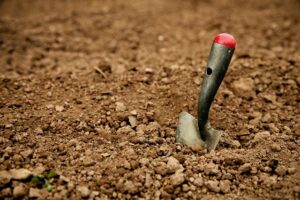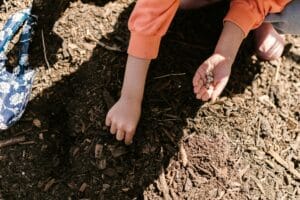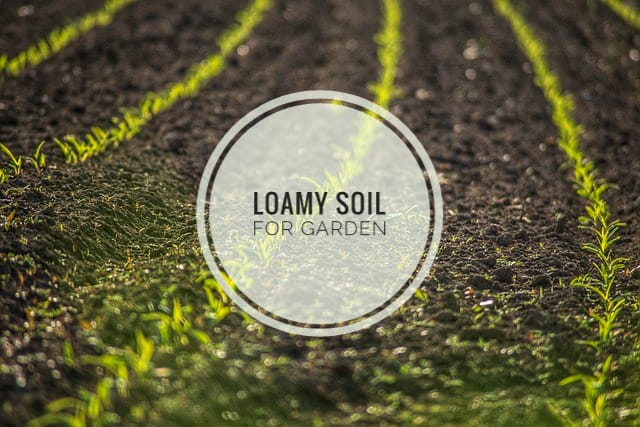Have you ever wondered why some gardens thrive effortlessly while others struggle despite care? The secret often lies in how loamy your soil is ?
Loamy soil provides a perfect balance of sand, silt, and clay, making it rich, fertile, and easy to work with. If you’re a beginner gardener, learning about loamy soil can completely change the way you grow plants.
WHAT IS LOAMY SOIL?
Loamy soil is a mixture of three key components: sand, silt and clay. This mix creates a balanced texture that holds moisture yet drains well.
Loam is a type of soil made up of three main parts: sand, silt, and clay. By weight, it usually contains about 40% sand, 40% silt, and 20% clay.
Sand particles are the largest, more than 63 micrometers across, which gives soil its gritty feel.
Silt particles are smaller, more than 2 micrometers, making the soil smooth and soft.
Clay particles are the tiniest, less than 2 micrometers, which is why they feel sticky when wet.
This perfect balance gives loamy soil its soft, crumbly texture and makes it excellent for gardening.
It is often dark in color, soft to touch, and crumbly when squeezed. Unlike heavy clay soil, it does not stick together excessively. Unlike sandy soil, it does not lose water quickly.

CHARACTERISTICS OF LOAMY SOIL
Loamy soil has several unique qualities. Here are the main features that make it special:
- Texture: Soft, crumbly, and easy to dig.
- Drainage: Retains water but does not stay soggy.
- Nutrients: Rich in minerals and organic matter.
- pH Balance: Usually close to neutral, around 6 to 7.
- Workability: Simple to till, plant, and maintain.
These properties create an environment where roots can breathe, absorb nutrients and grow healthily.
FORMATION OF LOAMY SOIL
Loamy soil forms naturally when sand, silt and clay combine in balanced amounts. Organic matter also mixes in, enriching the soil.
Over centuries, weathering, wind and water transport particles from rocks and deposit them in layers. Decomposed plants and animals add humus, boosting fertility.
This natural process explains why loam is often found in river valleys and fertile plains where agriculture flourishes.
BENEFITS OF LOAMY SOIL
Gardeners and farmers prefer loam for many reasons. Some of the top benefits include:
- Excellent Water Balance: Retains enough moisture but prevents waterlogging.
- Rich in Nutrients: Provides plants with essential minerals for growth.
- Supports Root Growth: Loose texture allows roots to spread easily.
- Versatile Use: Suitable for vegetables, fruits, flowers, and trees.
- Improves Yield: Plants grown in loam usually produce better harvests.
Because of these qualities, loam is often called “the gardener’s dream soil.”

CROPS AND PLANTS THAT THRIVE IN LOAMY SOIL
Many plants grow beautifully in loamy soil. Here are some popular examples:
- Vegetables: Tomatoes, carrots, beans, spinach, and potatoes.
- Fruits: Papaya, mango, banana, and citrus trees.
- Flowers: Roses, marigolds, chrysanthemums, and sunflowers.
- Field Crops: Wheat, sugarcane, pulses, and oilseeds.
Almost every common garden plant benefits from loamy soil, which explains its popularity.
HOW TO CHECK IF YOU HAVE LOAMY SOIL
Many gardeners are unsure about the type of soil in their backyard. Luckily, identifying loamy soil is simple and does not require special tools. Here are a few easy methods you can try at home:
- Touch Test: Take a handful of moist soil and rub it gently between your fingers. Loamy soil feels soft, slightly gritty from sand, yet smooth because of silt. Unlike clay, it will not feel sticky, and unlike pure sand, it won’t feel overly rough.
- Squeeze Test: Pick up some damp soil and press it in your palm. Loam forms a soft ball that holds together but crumbles when you apply gentle pressure. This balance shows the right mix of sand, silt, and clay.
- Color Check: Most loamy soils appear dark brown to almost black, thanks to organic matter. A lighter or very pale color usually indicates sandy soil, while a heavy, reddish tone often suggests clay.
- Drainage Test: Dig a small hole about 30 cm deep, fill it with water, and observe. If the water drains in a few minutes yet leaves some moisture behind, your soil is likely loamy. Too fast means sandy soil, and too slow indicates clay.
- Root Growth Clues: Plants in loamy soil usually develop strong, well-spread roots. If your garden plants look healthy, upright, and green with steady growth, your soil may already be loamy.
By combining these tests, you can quickly tell whether your soil is naturally loamy or needs improvement.

IMPROVING OTHER SOILS TO LOAMY TEXTURE
Not everyone is lucky to have natural loamy soil, but you can improve what you have.
- Clay Soil: Mix in sand and compost to loosen it.
- Sandy Soil: Add organic matter to retain moisture.
- Silty Soil: Use compost and mulch to increase drainage.
Regular addition of compost, manure, or leaf mold enriches any soil, slowly turning it loamy.
MAINTAINING LOAMY SOIL
Even loam needs care to stay fertile and healthy. Here’s how you can maintain it:
- Mulching: Spread organic mulch to prevent moisture loss.
- Crop Rotation: Alternate crops to avoid nutrient depletion.
- Composting: Add compost regularly for organic richness.
- Avoid Overwatering: Excessive water damages structure and invites disease.
- Minimal Tillage: Avoid heavy digging to protect soil organisms.
With good care, loamy soil can stay productive for years.
ENVIRONMENTAL IMPORTANCE
Loamy soil is not just useful for farming, it also benefits the environment.
It reduces soil erosion because of its stable structure. Its organic matter captures carbon, helping fight climate change. The water-retaining capacity reduces irrigation needs, conserving resources.
Healthy loam also supports biodiversity by providing habitat for earthworms, microbes, and insects.
COMMON MISTAKES WITH LOAMY SOIL
Gardeners sometimes misuse loamy soil despite its advantages. Avoid these errors:
- Over-fertilizing, which disturbs the natural balance.
- Using chemical pesticides excessively, harming soil life.
- Leaving soil bare, leading to erosion.
- Ignoring pH levels and not testing soil regularly.
By avoiding these mistakes, you keep your soil fertile and sustainable.
COMPARISON OF SOIL TYPES
| Feature | Sandy Soil | Clay Soil | Loamy Soil |
|---|---|---|---|
| Texture | Rough, gritty, loose | Sticky, heavy, hard when dry | Soft, crumbly, balanced |
| Drainage | Very fast, dries quickly | Very slow, holds water | Balanced, drains but stays moist |
| Nutrients | Low, washes away easily | High, but often unavailable | Rich, accessible to plants |
| Workability | Easy but unstable | Difficult, hard to dig | Easy to dig and plant |
| Plant Growth | Plants dry out quickly | Roots struggle to spread | Strong roots and steady growth |
LOAMY SOIL IN INDIA
In India, loamy soil is widely found across fertile river valleys and plains.
The Indo-Gangetic plains, parts of Maharashtra, Karnataka, and Tamil Nadu have large areas of loamy soil. Farmers use it for growing cereals, fruits, vegetables, and cash crops.
Because of India’s agricultural diversity, loam plays a vital role in food production and rural livelihoods.

INTERESTING FACTS
Here are some lesser-known but fascinating facts:
- Loamy soil contains about 40% sand, 40% silt, and 20% clay.
- Earthworms are natural friends of loam, improving fertility.
- Loam absorbs rainwater better than sandy soils, reducing flooding risk.
- It is considered “all-purpose soil” because it suits nearly all crops.
- Builders sometimes prefer loam for landscaping because it supports healthy lawns.
FAQs
Q1. Why is loamy soil considered the best for plants?
Loamy soil has a perfect mix of sand, silt, and clay. This balance allows proper drainage, nutrient availability, and moisture retention for healthy plant growth.
Q2. How can I make my soil loamy?
You can improve your soil by adding organic compost, manure, and mulch. Mixing sand with clay soil or compost with sandy soil also helps.
Q3. Which crops grow best in loamy soil?
Loamy soil is suitable for a wide variety of crops like wheat, sugarcane, vegetables, and fruits. Even ornamental flowers thrive in this soil type.
Q4. Does loamy soil need fertilizer?
Yes, but in moderate amounts. Loamy soil is naturally fertile, but regular addition of organic matter ensures long-term productivity and balanced nutrition.
Q5. Is loamy soil good for potted plants?
Loamy soil is excellent for pots, but it should be mixed with organic compost or cocopeat. This keeps it light, airy, and well-draining.
CONCLUSION
Loamy soil truly deserves its reputation as the gardener’s best friend. Its balanced texture, rich nutrients, and adaptability make it perfect for beginners and experts alike.
If your garden already has loam, you are fortunate. If not, don’t worry—simple improvements can transform your soil into loamy goodness.
A thriving garden begins with healthy soil. Once you understand loamy soil, you’ll notice how easily plants reward you with lush growth and harvests.
Thanks for reading. Keep growing, keep exploring, and don’t forget to return here at gardeningbud.com for more plants, tips and gardening wisdom.
